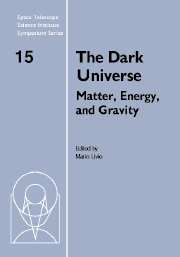Book contents
- Frontmatter
- Contents
- Participants
- Preface
- A brief history of dark matter
- Microlensing towards the Magellanic Clouds: Nature of the lenses and implications on dark matter
- Searching for the Galactic dark matter
- Hot gas in clusters of galaxies and ΩM
- Tracking the baryon density from the Big Bang to the present
- Modified Newtonian Dynamics and its implications
- Cosmological parameters and quintessence from radio galaxies
- The mass density of the Universe
- Growth of structure in the Universe
- Cosmological implications of the most distant supernova (known)
- Dynamical probes of the Halo Mass Function
- Detection of gravitational waves from inflation
- Cosmological constant problems and their solutions
- Dark matter and dark energy: A physicist's perspective
Microlensing towards the Magellanic Clouds: Nature of the lenses and implications on dark matter
Published online by Cambridge University Press: 21 August 2009
- Frontmatter
- Contents
- Participants
- Preface
- A brief history of dark matter
- Microlensing towards the Magellanic Clouds: Nature of the lenses and implications on dark matter
- Searching for the Galactic dark matter
- Hot gas in clusters of galaxies and ΩM
- Tracking the baryon density from the Big Bang to the present
- Modified Newtonian Dynamics and its implications
- Cosmological parameters and quintessence from radio galaxies
- The mass density of the Universe
- Growth of structure in the Universe
- Cosmological implications of the most distant supernova (known)
- Dynamical probes of the Halo Mass Function
- Detection of gravitational waves from inflation
- Cosmological constant problems and their solutions
- Dark matter and dark energy: A physicist's perspective
Summary
A close scrutiny of the microlensing results towards the Magellanic clouds reveals that the stars within the Magellanic clouds are major contributors as lenses, and the contribution of MACHOs to dark matter is 0 to 5%. The principal results which lead to this conclusion are the following:
(i) Out of the ∼17 events detected so far towards the Magellanic Clouds, the lens location has been securely determined for one binary-lens event through its caustic-crossing timescale. In this case, the lens was found to be within the Magellanic Clouds. Although less certain, lens locations have been determined for three other events and in each of these three events, the lens is most likely within the Magellanic clouds.
(ii) If most of the lenses are MACHOs in the Galactic halo, the timescales would imply that the MACHOs in the direction of the LMC have masses of the order of 0.5 M⊙, and the MACHOs in the direction of the SMC have masses of the order of 2 to 3 M⊙. This is inconsistent with even the most flattened model of the Galaxy. If, on the other hand, they are caused by stars within the Magellanic Clouds, the masses of the stars are of the order of 0.2 M⊙ for both the LMC as well as the SMC.
(iii) If 50% of the lenses are in binary systems similar to the stars in the solar neighborhood, ∼10% of the events are expected to show binary characteristics.
[…]
- Type
- Chapter
- Information
- The Dark UniverseMatter, Energy and Gravity, pp. 14 - 23Publisher: Cambridge University PressPrint publication year: 2004
- 3
- Cited by



